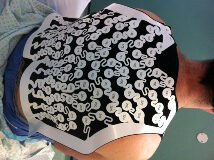In the previous Bioblog we looked at the mechanisms which control the Cardiac Cycle, here we are going to consider some of the ways in which problems arise and the effect of these on circulation of blood.
Resting and Maximum heart rates
The normal resting beat of the heart is between 60 and 100 beats per minute but there is considerable variation, one Olympic XC skier had a resting heart rate of 29 beats/minute! The heart can beat much faster than this during exercise when more oxygen is required by rapidly respiring muscle. The maximum heart rate (i.e. beats per minute) depends on age, fitness, general health and other factors. The heart rate of Olympic Cross-Country skiers was measured during competition and shown to increase with exercise but as the intensity of exercise increased, the heart rate started to plateau, this is the maximum heart rate for that athlete. Since maximum heart rate for a 10-15 year old is about 220 beats/minute and declines by about 1 beat per year, an estimate of the maximum heart rate for an individual is 220 – age.
This is only an estimate and there is considerable variation of maximum heart rate for any age group.
Variations in the rate of the heart cycle
Very slow heart rates (Bradycardia) of fewer than 60 beats/minute are not uncommon in healthy, fit individuals. Trained athletes, notably those associated with endurance sports such as marathon running and cycle road racing, have low resting heart rates; however low rates may be related to underlying problems such as low secretion of Thyroxin from an underactive Thyroid gland.
Resting heart rates of over 100 beats per minute (Tachycardia) can be related to disease such as fever, or an over secretion of Thyroxin. Of course elevated heart rates occur with exercise, but can also be caused by secretion of Adrenalin from the Adrenal Medulla when frightened, the “fight or flight” reflex.
The third variation in the heart cycle is where the heart does not have a settled rhythm or where extra beats often occur. These extra beats are called Ectopic beats. Again, this is not necessarily a symptom of disease, for example most people will have felt the effect of the heart giving an occasional extra beat or where the heart races for a while (palpitations). Caffeine from coffee and tea may cause ectopic beats as may excessive consumption of alcohol. There are, however, persistent malfunctions in regulation of the heart rate, these are known as arrhythmias.
Arrhythmias
These are often caused by dysfunction of the electrical control of the heart cycle, resulting in inefficiency in the heart’s action of pumping blood. The feature of these persistent arrhythmias is ineffective contraction of the heart muscle because insufficient time is given for the muscle to contract before another electrical excitation arrives. This results in the heart vibrating rather than pulsing, this may occur in the atria or in the ventricles; in the latter case immediate emergency treatment is necessary.
The usual route of electrical stimulation of the heart is by the Sino Atrial Node (S A node or “Pacemaker”) and then the electrical pulse spreads out over the atria and in the process, energises the Atrioventricular node, this in turn channels the impulse into the ventricles via the Bundle of His (see Bioblog 4 – June 2013).
In the case of Atrial Fibrillation the electrical activity from the S A node does not decay, but atria tissue causes repeated pulses to be generated within the muscle of the atria. This causes the walls of the atria to quiver. In turn the weak, disorganised electrical pulses are picked up by the Atrioventricular node and transmitted into the ventricles which also quiver rather than pulse correctly.
Ventricular Fibrillation has a similar cause, but is much more serious.
Diagnosis of Arrhythmias
This is usually done by the patient being connected to an Electrocardiogram (ECG). The electrodes, which are stuck to the surface of the skin, record electrical activity within the heart and may both demonstrate the condition and locate where the abnormal excitation occurs within the heart.
Another method is to feed an electrode attached to a minute camera and light source into a vein and guide this into the heart. Often this method is used for a procedure called Ablation where radiofrequency electricity, ultrasound, laser light or cryogenic treatment is used to disrupt the pathways used by the extra electrical stimulation. This technique, Cather Ablation, is the most common method of treating the condition.

One of the most difficult problems with either of these investigative methods is recordingarrhythmias which are irregular in onset. One approach to this problem is to connect the skin patch electrodes on patient to a portable datalogger, from which data can be downloaded from time to time, sometimes using a telephone connection.
(Copyright © 2011-2013 MediaSphere Medical LLC. All Rights Reserved.)
Improvements in diagnosis and treatment are important because it is estimated that about a million sufferers are hospitalised in the USA alone. A recent innovation at Imperial College, London is a vest containing electrodes which not only pick-up extra electrical activity in the heart, but also pin point where the activity originates. Here is a picture of the vest in use:
© 2013 Imperial College Healthcare NHS Trust
Now try these questions
Read the article ”Arrhythmias” from item 1 in the suggested reading list below, then answer the following questions:
- How does the normal heart cycle differ from that of an arrhythmiatic heart?
- Describe how disruption of electrical stimuli can lead to malfunction of the heart.
- Describe “Heart Block”. How could Heart Block be recognised?
Read the Imperial College article in item 2 and “How arrhythmia is diagnosed” in item 3 of the suggested reading list below then answer the following questions:
- What are the problems in diagnosing arrhythmias?
- What techniques and equipment are there to help clinicians diagnose arrhythmias?
- Discuss why health care should spend money on treating arrhythmia when there are many other demands on medical resources.
Reading around the subject
- http://www.patient.co.uk/health/arrhythmias-abnormal-heart-rhythms
- http://www.imperial.nhs.uk/aboutus/news/news_039255
- http://www.medicalnewstoday.com/articles/8887.php
You might like to work out your own maximum heart rate but use a bit of sense in interpreting or using any data about your own physiology. There are also instructions on the following site for calculating your Target Heart Rate, a figure which athletes use to maximise their training benefit:
http://btc.montana.edu/olympics/physiology/cf02.html
Some examples of syllabus content for which the above exercise is relevant:
Sphenodon





